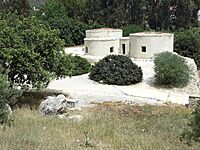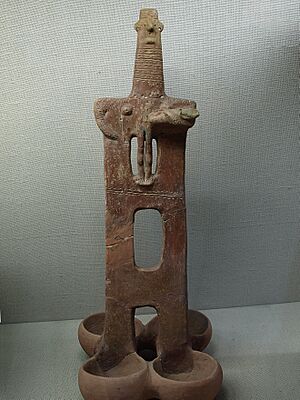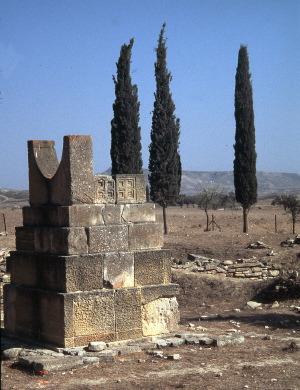Prehistoric Cyprus facts for kids
The Prehistoric Period of Cyprus is the time before people started writing down its history. This long period began around 11,000 BC and ended around 800 BC. Let's explore the amazing story of the first people who lived on this beautiful island.
Contents
The First People and Animals
Long before any people lived on Cyprus, the island was home to some unique animals. These included the Cypriot pygmy hippopotamus and the Cyprus dwarf elephant. These animals were much smaller than the hippos and elephants we know today. This happens to animals that live on islands for a long time, a process called insular dwarfism.
The first humans arrived on Cyprus around 11,000 BC. They were hunter-gatherers, meaning they hunted animals and gathered plants for food. Archaeologists have found evidence at sites like Aetokremnos that these early people hunted the dwarf hippos and elephants. These first Cypriots likely came from the nearby Levant region. Later, they brought wild boar to the island to have another source of food.
The First Farmers and Villages
The Neolithic, or "New Stone Age," was a time of big changes in Cyprus.
Life Before Pottery
Around 8800 BC, new settlers arrived who knew how to farm. At first, they didn't make pottery, so this time is called the Aceramic (or "no pottery") Neolithic. These farmers brought new animals to the island, like dogs, sheep, and goats. They also brought wild animals like foxes and Persian fallow deer.
They built villages with round houses made of mudbrick on stone foundations. The floors were made from a special plaster of burned lime. People in these villages grew crops like einkorn and emmer wheat. One famous site from this time is Choirokoitia.

Archaeologists also found some of the world's oldest water wells in Cyprus, dating back over 9,000 years! This shows how clever these early settlers were. People at this time did not live as long as we do today, often only into their 30s.
In 2004, a very special discovery was made. The grave of a person from 9,500 years ago was found, and buried with them was a small cat. This is one of the oldest examples of a pet cat in the world, long before the time of the ancient Egyptians.
Learning to Make Pottery
The early farming culture ended suddenly around 6000 BC. For about 1,500 years, we don't know much about what happened on the island. Then, around 4500 BC, new people arrived and started the Ceramic Neolithic period. This time is named for the pottery they made.
A key settlement from this time is Sotira. The houses here were different. They were usually square with rounded corners and had their own fireplace. People made monochrome (single-colored) pottery with combed patterns.
The Age of Copper and Stone
Around 3800 BC, a big earthquake may have destroyed the Neolithic villages. The period that followed is called the Chalcolithic period, which means "Copper and Stone" Age. This is because people started using the first metal tools, made of pure copper.
During this time, people made beautiful pottery with red-on-white designs. They also carved small figures from stone and clay. The discovery of a copper chisel at a site called Erimi is one of the oldest metal finds in Cyprus so far.
Some people started to become wealthier than others. We can see this because some graves had rich gifts buried with the person, while others had none. This suggests the beginning of social classes.
The Bronze Age: An Era of Metal and Trade
The Bronze Age was a very important time for Cyprus. It is when the island became famous for its copper resources.
The Start of the Bronze Age
Around 2400 BC, people from Anatolia (modern-day Turkey) moved to Cyprus. They brought new technology with them. They knew how to make bronze, a strong metal made by mixing copper with tin. This was a huge step forward.
These newcomers also introduced the plough for farming, the donkey for transport, and new ways of building houses. They built rectangular homes from mud-brick. Cattle were also brought back to the island.
The Middle Bronze Age
The Middle Bronze Age (about 1900–1600 BC) was mostly a peaceful time. People lived in organized towns with straight lanes, like at Marki Alonia. However, towards the end of this period, people started building fortresses. This suggests there was some unrest or danger.
During this time, Cyprus became known as Alashiya. This name is found in ancient records from Egypt and other powerful kingdoms. The oldest copper workshops were found at Pyrgos-Mavroraki.
A Golden Age of Trade
The Late Bronze Age (starting around 1600 BC) was a time of great wealth for Cyprus. Cities like Enkomi grew into major trade centers. Cyprus traded with Egypt, the Aegean islands, and the Near East.
A new form of writing, called the Cypro-Minoan syllabary, was introduced. This was a major step for the island's culture. Grand buildings made of large, cut stone blocks were constructed in the cities. These buildings show that society was becoming more organized.
Around 1200 BC, this peaceful time was disrupted. Groups of people known as the Sea Peoples attacked many places in the Mediterranean, including Cyprus. Some Cypriot towns were destroyed.
After this, Mycenaean Greeks began to settle on the island in larger numbers. They brought their culture, pottery styles, and language with them. This was the beginning of the Hellenization of Cyprus, meaning it became more Greek.
The Iron Age: Greek and Phoenician Influence
The Iron Age began after the Bronze Age, around 1050 BC. During this time, the culture of Cyprus became mainly Greek. New pottery styles and burial customs arrived from the Aegean Sea.
Legends written down much later say that Greek heroes from the Trojan War founded many cities in Cyprus. For example, Teucer was said to have founded Salamis, and Agapenor founded Paphos. While these are stories, they show the strong connection people felt between Cyprus and Greece.
The first proof of the Greek language on the island comes from this time. An inscription was found on a bronze skewer from around 1000 BC.
During the 8th century BC, Cyprus became very wealthy again through trade. The "royal tombs" of Salamis show this wealth. Chariots, ivory furniture, and huge decorated bronze bowls were placed in the tombs for the rulers.
At the same time, Phoenicians from the coast of the Levant also came to Cyprus. They founded cities like Kart-Hadasht (modern Larnaca) and traded across the island.
The Prehistoric Period in Cyprus ends when people began to write down history, first by the Assyrians and later by the Greeks and Romans.
Images for kids
See also



